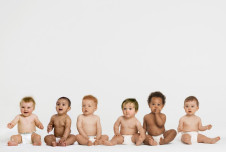Decades of psychological research has shown that people exhibit a strong preference for members of their own group over members of other groups, and these preferences surface even in young children. Yet other research, guided by psychologist Gordon Allport’s “contact theory,” suggests that, under the right conditions, these prejudices can be challenged by exposing people to members of other groups.
A study recently published in Psychological Science tested the contact theory. The study, conducted by researchers in Israel and Ethiopia, measured the length of time that 36 three-month-old infants looked at faces of individuals from their own race versus faces of people from different racial backgrounds. Infants were first separated into three groups based on their race and their living environment: Caucasian infants living in a Caucasian environment in Israel; African infants living in an African environment in Ethiopia; and African infants living in a predominantly Caucasian environment in Israel. The researchers then showed the infants a series of pictures of Caucasian faces side-by-side with African faces. With each pair of faces, experimenters recorded which face the infants focused on for a longer period of time; they considered the amount of time the infants spent looking at that face to reflect their overall preference for faces of that race. The researchers wanted to see whether the infants’ racial preferences were related to the environment in which they lived.
 An example of pairs of photographs used by researchers in their study of racial preference
An example of pairs of photographs used by researchers in their study of racial preference
The results showed that those infants living mainly among people of their own race—Caucasian infants living in Israel and African infants living in Ethiopia—preferred to look at faces of people from their own racial group. However, African infants living in a Caucasian environment showed no particular preference for African or Caucasian faces.
“Although these findings indicate that preference for own-race faces emerges out of very early exposure to prototypical perceptual environments,” the researchers write, “they also demonstrate that significant exposure to other-race faces can block the development of own-race preference.” They argue that because racial preferences early in life can lead to racial prejudices later, further research should determine precisely when these racial preferences might be altered by exposure to people of other races.





Comments